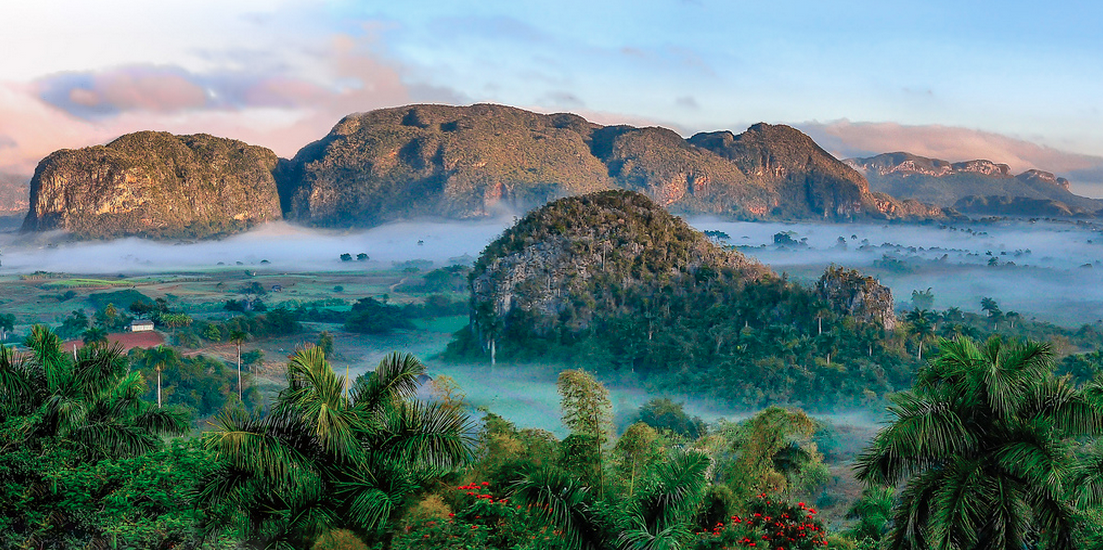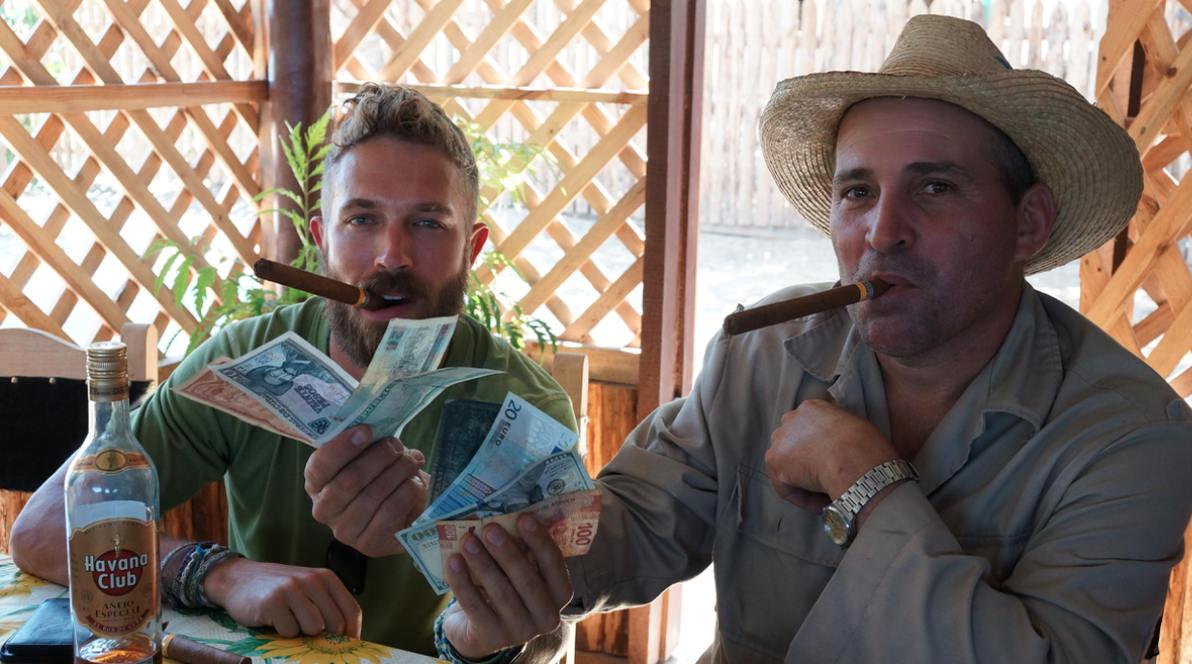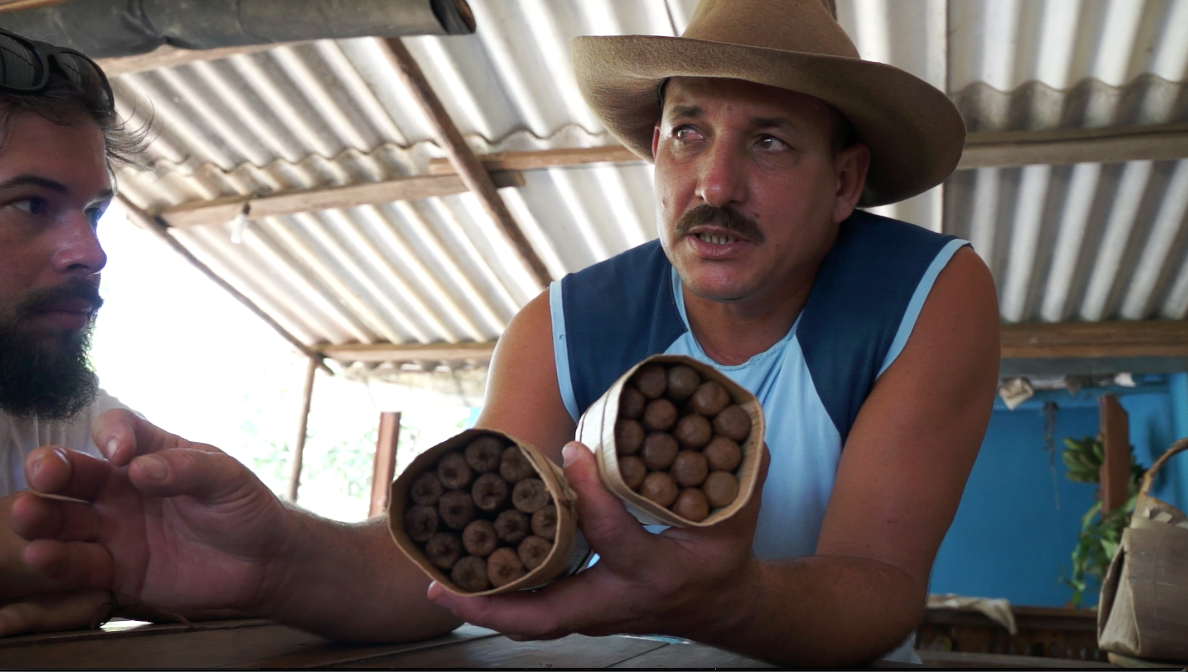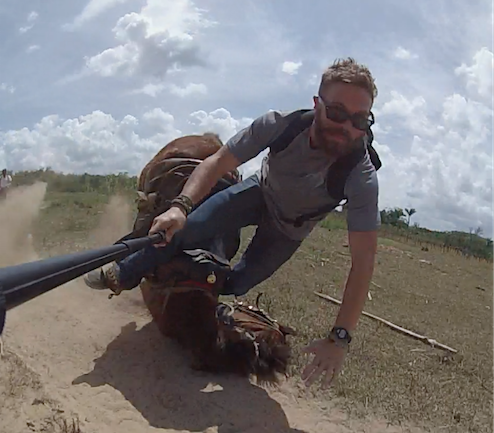“Esto no es un Habano verdadero.”
“This is not a real Cuban cigar.”
…our taxi driver said matter-of-factly as he rolled the end of my cigar back and forth between his fingers and little pieces of tobacco leaves dropped out.
I snatched the cigar from him, put it back in my mouth, and annoyingly retorted,
“¡Por lo menos dejame fumarlo en paz, hombre!
At least let me smoke it in peace, man!
We were on our way to Viñales, Cuba, and had just left Havana with a million and one dudes trying to sell us cigars in the rear-view. The last thing I wanted was another Cuban trying to hustle me. Plus, I had bought these cigars from a friend, so I was sure they were legit.
But it turns out he was right.
Moments later, I lit up another cigar at the tobacco farm we stopped at and immediately noticed the difference. This cigar was more dense, the tobacco leaves were packed tighter, the ash at the end of the cigar didn’t fall for ages, but above all….the taste. I went from smoking a fake Cohiba to the real deal in 15 minutes, and even for a cigar rookie like me, it was noticeably different.
As I sat back & exhaled the smoke from my first ever real Cuban cigar with complete satisfaction, the farmer tossed a hefty wad of tobacco leaves onto the table in front of us with a soft thud, adjusted his sombrero, & began to explain his trade. We were finally in Viñales.
Viñales – THE Cuban cigar destination
Like I mentioned before, there are cigar factories all throughout Cuba, cigar hustlers on every corner in every city, and even countless tobacco farms sprinkling the countryside along the highways, so why does one need to go to Vinales?
Although only 1.5–2 hours outside of Havana, Viñales looks & feels like a world away from the bustling & hectic Cuban capital. The gas-guzzling maquinas (old, American cars) & noise pollution of the city are replaced with the clip-clop of horse-drawn carriages & the creak of front porch rocking chairs. The crumbling concrete buildings & industrialized, urban Cohiba factories give way to farmers cracking their whips, pushing their oxen further into the hot sun to till the fertile land upon which their fathers & grandfathers made their living. They continue the tradition on today. These tobacco farms picturesquely wedged between the sugar-loaf, mogote mountain walls of the Valle de Viñales (Viñales Valley) are all they know.

The conjunction of this area’s natural beauty, rich farming traditions, and preserved harvesting techniques of the best tobacco known to man have propelled the Valle de Viñales to enjoy the UNESCO World Heritage site status it holds today.
All cigars are 100% hand-rolled, and most of the farms here are completely organic as they don’t use chemicals nor farming machinery! Not only is seeing Cuban tobacco farmers’ process awesome, but being able to support them is even better. As noted in the video, the Cuban government takes 90% of their product to the Cohiba factories to produce & sell to tourists in official cigar shops. Buying cigars directly from the farmers puts money straight into their pocket, and given that most Cubans’ official salaries range from $15-30/month, that’s money well spent.

Furthermore, purchasing artisan cigars, hand-rolled & packaged with no labels (also seen in the video at the 2nd farm) can give tourists more options to take Cuban cigars back home. For officially packaged, branded cigars, such as Cohiba or Montecristo, purchase receipts are required to pass customs. These cigars cost about $10-30 apiece in government-run cigar shops. With exporting good limits enforced at airports (capped at $100 worth of cigars for Americans), that doesn’t give you much wiggle room for bringing some stogies back to share with your friends. The artisan cigars shown below cost us $2 each, and they tasted just as good as the official Cohibas.

But, I don’t even like cigars!
Just so you know, I never liked cigars before I went to Cuba either. By the time I left, I was smoking a cigar every day! I dare you to try one & see what happens.
But even if you’re sure you’re not going to like the cigars, there are still plenty of reasons to visit Vinales. There are hiking & horseback-riding trails all over those beautiful, green mountains, rock-climbing is starting to take off, and other family-friendly activities like boat-riding through Cueva del Indio and visiting Mural de la Prehistoria are worthy sideshows.
That being said, I still strongly recommend at least riding horses through the valley to visit the farms & learn about the tobacco farming process (you can just drink the mojitos if you prefer ;). Here’s who we contracted at a cost of $4/hour per horse:
Nombre (name): Yaniel. Teléfono: (+53) 52238887 or 53715648. Dirección (address): Salvador Cisnero Este, Carretera Al Cementerio. Viñales, Pinar del Rio, Cuba. (also has a Casa Particular for $25/night)
Yaniel doesn’t speak English however, but just like any experience in Cuba, speaking some Spanish will no doubt enhance your experience! Brush up on your vocabulary with the list below, and we’ll see you at the Vinales, Cuba tobacco farms!
P.s. – make sure Yaniel doesn’t give you the horse “Pepe” – he can be a little loco some days

Pepe & I – best buds
SPANISH VOCABULARY LIST FROM VIDEO:
plantación – plantation
secadero – dryer (in the video’s context, dry house)
Estoy rodeado – I’m surrounded
una explicación – an explanation
las hojas – the leaves
la ceniza – the ash
picada(o) – chopped up
abajo – below, bottom
arriba – up, above
fuerte – strong
una capa – a layer
capote – literally cloak, or cape (but in this context it means the interior wrapping layer of the cigar)
moldearse – to mold
barra – bar
ciento ochenta – 180
doscientos – 200
gobierno – government
noventa por ciento – ninety percent (90%)
por supuesto – of course
lo mejor – the best
entonces – so, well, then
lo has probado – you have tried it
tomar fotos – to take photos
la planta – the plant
recolectar – to recollect, to pick
la primera – the first
la mañanita – the little morning (first picking of tobacco leaves in this context)
la segunda – the second
libre pie – free foot (second picking of tobacco leaves in this context)
siempre – always
la tercera – the third
cuarenta y cinco – 45
cincuenta – 50
uno y medio – one and a half (third picking of tobacco leaves in this context)
la cuarta – the fourth
centro fino – fine center (fourth picking of tobacco leaves in this context
la quinta – the fifth
centro gordo – fat
la última – the final, the last
la corona – the crown (the final picking of tobacco leaves in this context)
hay – there are, there is
rey(es) – king(s)
casi – almost
entre– between
setenta y cinco – 75
la cosecha – the harvest
a mano – by hand
máquinas – machines (also refer to the old, American cars in Cuba!)
en absoluto – at all, absolutely
químicos – chemicals
biológico – biological
cantidad – quantity
cinco mil – 5 thousand (5,000)
un millón – one million (1,000,000)
dos millones – two million (2,000,000)
yank tank – old, American-made cars in Cuba (also known as maquinas)
sabroso – tasty
campesino – farmer, peasant
silencio – silence
suave – smooth
fabricar – to fabricate, produce
tripa – intestine (in this context, the interior of the cigar)
precio – price
etiqueta – label
cualquiera – anyone, any, whichever
experto – expert
aeropuerto – airport
caja – box
CUC – Cuban Convertible peso (pegged to the U.S. Dollar)
Did you find today’s Spanish lesson interesting or helpful? Do you like following along with dual-subtitles in videos, or would you prefer some other sort of Spanish-learning practices? I’m always looking for new ways to teach Spanish through documenting my travels, so I’m open to all suggestions & critique! Please let me know in the comments below & ¡hasta la próxima!

This was so interesting! I don’t like cigars but I definitely have Vinales on my trip radar now. Thanks
Thanks George I’m glad you enjoyed the video. Don’t hesitate booking a trip to Vinales, and feel free to use the exact some contact details from my time there. Best of luck!
OH MY GOODNESS! Such a wealth of amazing information! You have the best and most genuine posts about Cuba! 🙂 Thank you for sharing–I feel like I am there!!!
The best eh? Idk about that, but I try pretty hard to pass on the news, so I’m glad you found it useful! Hopefully one day you can go to Cuba and experience the real deal for yourself! Cheers
Did you open any of those cigars up? We just came back from a trip to cuba and had a tour of vinales. We did the cave nightclub and the tabacco/coffee tour. The guys making the cigars had the exact same pitch as the one in your video. All natural, 90% we sell to the government etc. That 10% they don’t sell to the government probably don’t make it past inspections. But when we bought the cigars, the tobacco farmers pulled a bait and switch on us. The cigars we got didn’t have the long leaf filler that they were showing us while they making the cigars. The binder was there and so was the wrapper, but the filler was all shredded tobacco, and other debris. The cigar was packed so densely because it’s all of the crap inside. It also explains why they dipped the cigar in honey and why the cigars tasted different. It’s not because the cigars were made “all naturally” it’s because they had scraps instead of filler leaves. I threw all of the ones we bought away. I felt like the con artists in havana were pretty obvious. But the whole horseback tour we had was full of local scammers too. They showed us how they made their coffee an talked about their rum. Then proceeded to mark up a 3.5 cuc rum from the store to 20 cuc.
Excellent article. Is that picture a painting or a live photo?
Thanks! All photos are real photos!
WTF…. i laughted loudly when i saw ur pictures falling of the horse.
DIOSSSSSSSSSSSSSSS… hahahahahahaha
Great job.